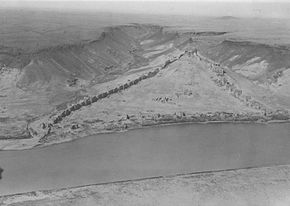Halabiye
| حلبيّة | |

Aerial photo of Halabiye with the Euphrates visible in the lower part of the image
|
|
| Alternate name | Latin/Greek: Zenobia, Birtha |
|---|---|
| Location | Syria |
| Region | Deir ez-Zor Governorate |
| Coordinates | 35°41′22″N 39°49′21″E / 35.689444°N 39.8225°E |
| Type | Fortified town |
| Area | 12 hectares (30 acres) |
| History | |
| Founded | 3rd century AD |
| Periods | Roman, Byzantine, Ayyubid? |
| Site notes | |
| Excavation dates | 1944, 1945, 1987, 2006–2009 |
| Archaeologists | J. Lauffray, S. Blétry |
| Condition | Ruinous |
| Management | Directorate-General of Antiquities and Museums |
| Public access | Yes |
Halabiye (Arabic: حلبيّة, Latin/Greek: Zenobia, Birtha) is an archaeological site on the right bank of the Euphrates River in Deir ez-Zor Governorate, Syria. It was an ancient city and former bishopric known as Zenobia and a Latin Catholic titular see.
Halabiye was fortified in the 3rd century CE by Zenobia, Queen of Palmyra, after whom the site was named in Antiquity. After her revolt against the Roman Empire in 273, Halabiye was captured by the Romans and subsequently refortified as part of the Limes Arabicus, a defensive frontier of Roman Syria to protect the region mainly from Persia. The site occupies an area of 12 hectares (30 acres), protected by massive city walls and a citadel on top of a hill. Remains of two churches, a public bath complex and two streets have been excavated. These all date to the reign of Byzantine Emperor Justinian I, who refortified the city in the 6th century AD.
The earliest description is found in the De Aedificiis ("On Buildings") by Procopius, who described the fortress in the 6th century CE. Upon archaeological investigation of the site, Procopius’ description turned out to be highly accurate, suggesting that he knew the site from personal observation. Halabiye has drawn the attention of European travelers and scholars since the middle of the nineteenth century. The English explorer Gertrude Bell passed the site on her travels in northern Mesopotamia and it was photographed by the French aerial archaeology pioneer Antoine Poidebard in the 1930s.
...
Wikipedia

